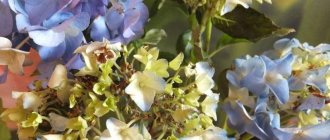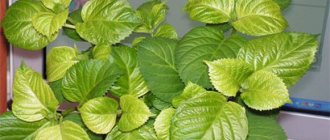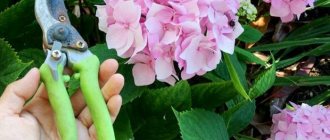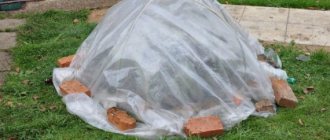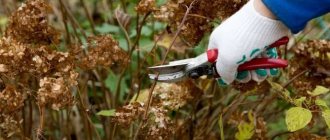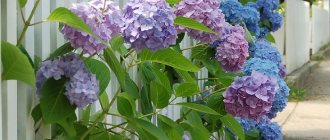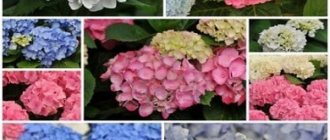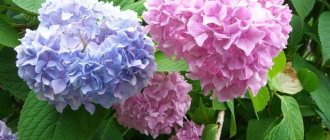When choosing unpretentious but beautiful plants to grow on your site, you should pay attention to garden hydrangea. This magnificent flower will transform any garden. It can be considered one of the most beautiful plants on the planet due to its incredibly lush flowering, the abundance of different shades of inflorescences and the absence of any special difficulties in growing them. The article will tell a story about the garden hydrangea flower (photo, description, growing conditions, etc.).
Watering
Many novice gardeners dream of beautiful plants in their plots, like in the photo.
Planting garden hydrangea and caring for it in the future is not difficult. Still, it is necessary to remember that for abundant flowering the plant must be provided with regular watering. It should receive a lot of moisture, especially if it is in a sunny place. To ensure continuous flowering in July, you can apply a third fertilizing in the form of humic or phosphorus-potassium fertilizers. Hydrangeas are very sensitive to watering. It is better to use warm water to moisten the soil. The plant does not like drought, so it needs regular watering. Light drying of the top layer of soil is acceptable, but no more.
Experts recommend using only soft water for irrigation. It could be rainwater. You can also use tap water, but then it will have to stand for five days. The sensitive root system of hydrangea does not like low temperatures, so water with a temperature above + 15 degrees is suitable for irrigation. On average, at least 16 liters of liquid per week must be poured under each bush. Watering should be done in the evenings or early mornings.
Diseases and pests
Hydrangea is quite resistant to pest attacks, but sometimes, if not properly cared for, it can be affected by spider mites, aphids and even ants, which easily spread from other “green neighbors”. Traditional methods and treatment with special insecticides help in pest control .
Diseases that can cause trouble are chlorosis, gray and white rot, powdery mildew, septoria and rust. If signs of disease are detected, damaged parts of the plant are removed and treated with specialized preparations.
Timely preventive measures to care for hydrangea are the key to its health and beauty
In the garden, blooming hydrangea can become a real decoration. If you provide the plant with proper care and attention, it will fill the space with the aroma of its flowers every year. Hydrangea looks great in solo or group planting and will be an excellent option for decorating various compositions with herbaceous, coniferous and other flowering shrubs and trees. It can be planted in the center of a large flower bed or surrounded by a lawn - in any case, the hydrangea will look great.
Author of the article: Polina Viktorovna Kolesnikova
- Related Posts
- Beautiful flowers and plants for the garden that definitely need to be planted in the garden
- Beautiful geranium - growing and care at home (photo)
- Growing and caring for oleander at home (photo)
« Previous entry
Hydrangea paniculata
This hydrangea can be called one of the most beautiful species. These are small trees whose height rarely exceeds 10 meters. It is often found in China and Japan; in Russia it thrives on Sakhalin. Hydrangea leaves have an elliptical shape, their average length is 12 centimeters. Hydrangea flowers form large panicles, they are characterized by an incredible sweet aroma, which is why they are excellent honey plants
Please note that this hydrangea grows very quickly and requires constant pruning.
It is recommended to grow paniculata hydrangea in a shady place. The thing is that under direct sunlight its inflorescences become small. Plants should also be protected from the wind. If you follow all the rules for caring for hydrangea, you will enjoy long and lush flowering, which will begin in June and last until October. Paniculata hydrangea is resistant to frost; it easily tolerates winter with cold snaps down to -25 degrees. Therefore, such a plant can be grown in both the central and northern parts of Russia. Speaking about what paniculata hydrangea looks like, it should be said that all varieties are different from each other. Let's look at the most popular of them.
Hydrangea propagation
You can propagate hydrangea in several ways:
- Seed propagation is used very rarely and for certain species.
- Reproduction by layering. Shoots older than one year are suitable for it. They are bent towards the soil and buried, leaving only the top of the shoot (at least 20cm) above the ground. In autumn or spring, when the shoot takes root, it is separated from the mother’s bush and transplanted to a chosen location.
- Dividing the bush. The entire plant is dug up and divided so that overwintering renewal buds remain on each part, then transplanted into prepared soil.
- Cuttings. For this type of vegetative propagation, cuttings are taken from an adult plant in mid-spring - early summer. Annual shoots up to 15 cm in size are cut at an angle of 90 degrees. The lower part is cleared of leaves, watered with a growth activator and planted in a greenhouse in seedling soil on a bed.
After planting hydrangea in open ground, it must be covered and pruned for a year.
If the bush is large, then it is propagated by division. If the bushes are small, then cuttings are used.
- The soil must be moist before dividing.
- They dig with a pitchfork to a depth of 15 centimeters.
- The bush is tilted and removed from the hole. The process requires precision. Otherwise, you can damage the roots.
- The rhizome is washed and cleared of soil.
Cuttings
Many gardeners use cuttings. In hydrangea, the cutting is a stem that has several buds. The shoots are cut off and lowered into the water. Their upper part is removed. It is not needed as a cutting. The remainder is divided into a couple of parts.
There are several leaves left on each of them. The cuttings are transferred to the solution, which stimulates the roots. Leaves should not get into this product. After the rhizomes appear, you can plant the plant in the ground.
Growing hydrangea in open ground
Hydrangea takes root best in open ground in early spring and autumn. In temperate and cold climate zones, it is recommended to plant hydrangeas in the spring. Over the summer, the seedlings should take root and settle well in the ground, this will help them survive the first winter.
Select a place for the plant in advance - it loves soils with high acidity and abundant moisture, direct sunlight and a little shade. Unfortunately, some species cannot tolerate the summer heat; due to the heat, the flowers can be crushed.
Planting Tips:
- Dig a hole 30 cm in length, width and height, add organic and inorganic fertilizers, turf, sand and mix, then add peat.
- Lightly trim the roots before planting, and leave part of the root collar uncovered with soil.
- Generously water the seedling with water, sprinkle with peat, if available, or humus.
- Shorten annual shoots by a couple of buds if you plant the plant in winter.
- If you plant several hydrangeas at once, keep a distance between them - it should be about one meter.
How to feed hydrangea
The first feeding of white hydrangea begins with awakening from winter rest, characterized by sap flow and the opening of the first buds. Organic or mineral fertilizers are applied after abundant watering to avoid chemical burns of the root system.
Excessive enthusiasm causes the bush to bloom irrepressibly. Thin branches break off under the weight of large inflorescences. During the period of growing green mass and during flowering, the plant needs different microelements.
Wood ash solution is contraindicated for hydrangeas as it alkalizes the soil. From the beginning of May to mid-June, hydrangeas are fed with a complex with a predominance of nitrogen. Throughout the summer, potassium fertilizers are applied to maintain the flowering phase. Since the beginning of September, hydrangea has not been fed so as not to provoke growth. In mid-September, reduce watering as the plant prepares for the winter dormancy phase.
Reproduction methods
There are four ways to propagate hydrangea:
- Cuttings.
- Dividing the bush.
- Layerings.
- Seeds.
The last option is the most labor-intensive and is suitable only for professional gardeners who are “dog-eaten” in this craft. It is better for a beginner to pay attention to the first three methods. Dividing the bush, which we already wrote about above, is simple: the plant is carefully dug up and divided into two parts. Renewal buds should remain on each part with roots. After this, they are planted in two different holes. Cuttings are the most popular method of plant propagation. A shoot is plucked off from an adult bush. The highest quality cuttings are obtained from side branches. The cut should be made under a node or under a bud. The cuttings are tied into bunches, unnecessary leaves are cut off, leaving one or two with buds on each.
The bottom of the bundle is treated with a growth stimulator. They are planted in drained soil at an angle. Cuttings usually take root within a month at temperatures of 15-25 degrees. Cuttings are carried out in mid-summer. To propagate layerings, the side branches of the mother bush are bent to the ground and pinned, buried in shallow holes. First, you need to make cuts on the branches into which matches are inserted. This tissue damage will promote accelerated root formation. The pinned shoots are sprinkled with a mixture of peat and soil. They need to be watered regularly. After the formation of a full-fledged root system, the plant can be separated from the mother plant and transplanted to another location.
How to deal with pests and diseases of hydrangea
Most cultivated varieties are resistant to diseases and are rarely attacked by insects. But it is advisable to know the methods of dealing with both:
- Downy mildew, powdery mildew. The solution to the problem will be to spray the bush twice with an interval of 10 days with a 3% Bordeaux mixture.
- Chlorosis. A solution of iron sulfate in a ratio of 10 g/10 l of water will help cope with the scourge. In case of severe damage, the concentration should be 50 g/10 l.
- Tracheomycosis. Watering the soil and spraying with an aqueous solution of the fungicide "Maxim" 2 ml/10 l is an effective way to combat the disease.
- Gray rot. The drug "Alirin-B" will come in handy. You need to dissolve 2 tablets in 1 liter of water and treat the bush with this composition.
- Root nematode. “Bazudin” in granules is embedded in moist soil at 1.5 g/m². This way you can get rid of the pest.
- Spider mite. The drug "Actellik" will help cope with the problem. The spraying solution is prepared in a ratio of 2 ml/2 liters of water and then the plant is treated.
- Aphids, leaf rollers. To fight, use Akarin. 2 ml of the drug is dissolved in 1 liter of water and the above-ground part of the flower is treated.
- Slugs. Shellfish are collected by hand. Broken nutshells scattered on the ground will help prevent the occurrence.
Possible problems
Chlorosis manifests itself in lightening of foliage
How to care for hydrangea if it loses its beautiful appearance? Despite its fastidious nature, the “Chinese beauty” is quite resistant to pests and diseases.
But some problems are possible:
- Chlorosis is expressed in the loss of color in the foliage: it loses its bright green color. The disease is associated with excess lime or humus in the soil. A solution of iron sulfate or potassium nitrate helps give the plant a healthy appearance. The bush is sprayed at intervals of 3 days.
- Downy mildew appears when there is excess air humidity. Initially, yellow spots appear on the foliage, which over time become dark brown. To combat the disease, use a solution of copper sulfate.
- Of the pests, aphids, spider mites and weevils pose a real danger. Aphids and spider mites feed on plant sap, causing a loss of turgor (elasticity) of cells. Weevils gnaw through flower buds and spoil the inflorescences. And this is the answer to the question why hydrangea does not bloom. In case of serious damage, the use of insecticides is necessary.
- Sometimes a fungus appears on hydrangeas. The phenomenon is rare, but possible. Copper oxychloride helps with it.
- The foliage is readily eaten by snails. They carefully remove the top layer of the leaf blade, leaving a transparent epidermis. When a clutch of snail eggs is detected, chemical baits are left in special containers under the bush.
Beautiful hydrangea in garden design
It is important to periodically inspect the plants so as not to miss signs of disease or pest infestation. With the right approach and treatment, hydrangea will gradually recover.
The video provides general information about hydrangea and its care:
Growing at home
As already mentioned, paniculate hydrangea is not particularly whimsical. Planting and caring for it do not require much effort, so even beginners who have never had indoor or garden flowers before can cope with everything. But in order for it to grow well and delight with its beauty, it is necessary to follow a number of rules. Here are the main ones:
- Hydrangeas belong to the group of moisture-loving flowers, so they require regular and abundant watering.
- It is not recommended to feed them with organic fertilizers, as they may prevent the plant from blooming.
- If you grow hydrangea in open ground, you need to prune it every year. It is needed not only to give the shrub better decorativeness, but also to rejuvenate it.
- Flowers must be covered for the winter. If this is not done before the first frost, the root system may be damaged, which can lead to the death of the flower. This also applies to frost-resistant species.
- If you want to make a landscape design in your garden and plan to create a flower arrangement in it, then choose the soil responsibly. By changing the acidity, you can get flowers of any shade you want.
- Many novice gardeners who do not know when to plant hydrangea and how to choose the right place to plant it make the same mistake. They do not take into account that this species loves warmth very much. Shrubs will do best on the south side of the house in partial shade. This way they will have enough heat and will not be damaged by direct sunlight.
The great advantage of hydrangeas is that they are highly resistant to diseases and harmful insects. With proper watering and timely application of fertilizers to the soil, no maintenance problems arise.
Landing
Proper planting of hydrangea gives the plant a better chance of being established in a new location. The shrub will bloom poorly and may become sick in an improperly prepared planting site.
When to plant?
It is difficult to determine the best planting date. Hydrangeas are sold in pots and planted from spring to late fall (April to November). This shrub does not tolerate low temperatures very well, so it is best to avoid planting in late fall to give the plant enough time to take root and acclimate to its new location.
Since in our climate garden hydrangea species may not have time to take root before winter, the plant should be planted when it is dormant. It is better to plant in the spring, when the soil warms up - in late April-early May. If severe frosts occur, young plants need shelter.
Hydrangeas planted in spring require regular and abundant watering during the growing season. Planting in the fall helps reduce the frequency of watering, but creates a risk of freezing of the bushes. When choosing an autumn planting date, it is necessary to carefully protect young plants for the winter.
It is better to plant hydrangeas on cloudy days early in the morning, then the plants are not threatened by rapid temperature changes.
From the time of purchase until the time of planting in the soil, seedlings should be stored in shaded and wind-protected areas and watered regularly to prevent the root ball from drying out.
Soil preparation
- Before planting, the area should be cleared of stones, construction debris, and weeds, especially deeply rooted ones, should be removed.
- Soil with too high a pH (above 6.5) should be acidified with peat or mulch. It is worth bringing the soil pH to 4.5-5.5.
- Light soils, highly permeable, low in nutrients and humus are enriched with compost, rotted manure or peat substrate at a dose of 40-60 kg per 10 m² of substrate. The addition of organic matter increases the water capacity of the substrate, enriches it with nutrients, improves density, and creates favorable conditions for the development of the root system of the planted shrub.
- Immediately before planting seedlings in the ground, it is worth adding hydrogel, fertilizers and substances that improve the soil structure. The hydrogel increases the water capacity of the soil, so the soil stays moist longer and the plant is less susceptible to drying out.
- In the case of heavy and compacted soils, preparation should begin a year earlier. To lighten the soil structure, it is mixed with a 10-centimeter layer of pine bark, gravel, peat or compost, and dug in the fall to a depth of 20-30 cm.
Planting technique - step by step
- Dig a hole with the same depth as the flower pot and 2 times its diameter. Plants are often planted in a hole with a diameter of 60-70 centimeters and a depth of 40-50 centimeters.
- Spread a few centimeter layer of manure or compost, acidic humus and garden soil. The components are mixed in a ratio of 1:1:2. If hydrangea is planted on heavy soil, the bottom of the hole is covered with a layer of drainage 10-12 centimeters thick, made of coarse gravel, vermiculite, and small pebbles.
- The seedling and pot should be immersed in a container of water. When the soil is wet, carefully remove the plant from the container, making sure that the root ball does not fall apart. Roots that are too long or damaged must be cut off. Root pruning encourages stronger root growth, making newly planted seedlings better accepted.
- Hydrangeas are planted to the depth at which they grew in the container. Only on sandy and very loose soils are they planted 3-4 cm deeper. The planting density of bushes depends on the vigor of growth:
- If several bushes are planted, the distance between them, depending on the type, should be 70-100 centimeters. Then caring for hydrangea will be easy.
- Dwarf varieties are planted at intervals of 50 × 50 cm.
- Strongly growing varieties are planted at a distance of 100 × 120 cm.
Care after landing
After planting, the soil around the bushes is compacted and a small side is made in which water will collect. Then the planted plants should be watered abundantly, preferably with rainwater, so as not to increase the pH of the substrate. When the water is absorbed, the soil should be replenished if small roots are exposed. A layer of mulch 6-10 cm thick is poured around the planted bushes. Mulching the soil helps maintain moisture in it, ensures cooling of the roots in the summer and protects them from frost in the winter. In addition, organic mulch increases the humus content in the substrate and improves its structure.
For mulching use:
- compost pine bark,
- softwood sawdust,
- a mixture of bark and peat,
- oak leaves.
Low-growing ornamental groundcover plants with shallow roots can also be planted around the hydrangea for mulch:
- periwinkle,
- ivy,
- pachysandra apex.
Wintering garden hydrangea
The most important disadvantage of garden hydrangea is its low winter hardiness: its annual shoots, in the upper part of which flower buds are formed in the fall, never ripen by autumn and go into winter green. These buds either do not have time to form at all in the early cold autumn (in the north), or without special shelter they die due to severe winter frosts (below minus 18 °C in the middle zone) or returning spring frosts. As a result, even heavily frozen shrubs restore the above-ground part by summer and, alas, do not bloom. In order not to be disappointed in hydrangea after the first non-blooming, you can plant decorative leaf specimens (“Maculata”, “Tricolor”, “Quadricolor”), which even without flowers will become an original decoration of the garden, but for growing flowering plants in our climatic conditions absolutely everything varieties need to be covered annually for the winter. Of course, in a general mixborder, the shelter, which will only be completely removed by the middle - end of May, will not look very representative, and organizing wintering for a hedge may turn out to be too troublesome, but, as connoisseurs of hydrangeas assure, the luxurious flowering of this shrub is worth the “ victims." In order to make it easier to organize a winter shelter, it is better to plant hydrangea separately from other flowers (on the lawn), but if the size of the plot does not allow it, you can plant it in a tub. This planting is good because the plant can be moved painlessly in order to better select the lighting for it, the color scheme of its neighbors, organize wintering (under cover or in a greenhouse) and it is necessary to ensure the optimal composition of the soil. This method is perfectly suited for the climate of the middle zone, where most varieties are generally recommended to be grown as poorly wintering chrysanthemums - with wintering in the cellar (not higher than +6 ° C) and planting in the ground in late spring after return frosts.
About the features of choosing a place for growing garden hydrangea
A photo of a bush hydrangea (or tree hydrangea) perfectly demonstrates that the plant is a real decoration of the site. Even beginners in gardening can grow this variety.
First of all, you need to choose a suitable place for the plant: it does not tolerate prolonged shading. The best place for hydrangea may be the sunny side of the site. It is recommended to plant seedlings either in early spring (in May) or in early autumn (in early September).
Freedom
The description of hydrangea, whose name translates as “freedom,” is amazing. Just imagine: the petals of a plant of this variety are able to change their color! Initially it is soft pink, but over time it becomes ultramarine. There is a white border on the edges of the petal, which looks simply amazing. Add to this the malachite leaves of hydrangea... Photos cannot fully convey the beauty of the plant. It's no wonder that gardeners from all over the world grow Freedom hydrangea in their gardens. Its advantages include not only its magnificent appearance, but also the strength of the shoots, which even in the strongest wind will not break under the weight of the inflorescences.
Popular types
There are about 80 species of wild hydrangeas in nature, some of them have been improved by breeders and are suitable for growing in the garden and for decorating the urban landscape. Let's look at the main types of graceful plants.
large-leaved
The lush shrub is most popular among gardeners. This type of hydrangea forms charming lush ball inflorescences. Large-leaved hydrangea is characterized by poor frost resistance and requires shelter for the winter and careful care. Needs regular watering and sanitary pruning.
Paniculata
It differs from large-leaved hydrangea in the shape of its inflorescences; it is cone-shaped. Blooms from July to October. Suitable for creating dry winter bouquets. In landscape design it is used to design areas of reservoirs. Less demanding for systematic care.
Chereshkova
Type of climbing hydrangea. It can reach a height of 10 meters, suitable for decorating gazebos and terraces. It is distinguished by high winter hardiness and exquisite aroma during the flowering period.
Tree-like
The plant is native to North America. Unpretentious to grow, forms spherical inflorescences. It needs regular pruning, overwinters well, and forms a spreading bush with a diameter of about 2 meters.
Ground cover
Decorative shrub of creeping type. The height of the plant is no more than 30 centimeters. Winter hardiness is average, used for decorating vertical surfaces or alpine slides.
Oakleaf
Deciduous shrub growing up to 2 meters high. It is distinguished by its original leaf shape, reminiscent of the leaf blades of oak or maple, which in autumn change color from green to red-brown.
How to care for a plant in open ground?
For beautiful, lush flowering of hydrangea, proper care is necessary.
Trimming
Hydrangea is one of the garden shrubs that can grow up to 30 cm in height in one season, and therefore this plant needs regular and preventative pruning.
The first is done on plants that have reached 3-4 years of age in early spring before sap flow and buds begin to bloom. You should prune during the period when the buds are swelling.
Important! Too early a procedure will result in unsuitable cuttings for further rooting. If pruning is delayed, the bush may die
. The plant is trimmed with pruning shears, cutting off ¾ of each shoot, leaving 2–3 pairs of buds. It is recommended to renew old bushes, so they are cut off almost to the root.
You can clearly see the procedure for pruning hydrangeas in this video:
Fertilizer
Like any garden plant, hydrangea needs complex fertilizing , which strengthens the branches of the plant, and makes the inflorescences themselves more lush and bright. Fertilizers are applied twice a year:
- In the spring, during the period of bud formation, 20 grams of urea per bucket of water (for an adult plant you will need 3 buckets of solution).
- After flowering, hydrangea is fed with complex mineral fertilizers, which necessarily include: nitrogen, potassium and phosphorus.
Reference! Over time, the acidity of the soil decreases, so it is periodically acidified.
You can learn more about fertilizers for hydrangea from this video:
After flowering
As soon as the hydrangea stops flowering, preparations for winter begin. The first thing to do is remove the flower stalks so that suddenly falling wet snow does not stick to them and break the fragile branches of the plant. There is no need to try to remove them to the very root, just cut them down to the middle. They also perform autumn preventative pruning: get rid of dry, diseased or broken branches.
Caring for shrubs in summer
Summer maintenance of hydrangea involves a set of agrotechnical measures that contribute to the favorable progress of all stages of its growing season:
- Regular watering (once a week - 2-3 buckets of rain or settled water, more often in hot weather).
- Removing weeds and shoots from the root circle, loosening to a depth of 10 cm and mulching up to 3 times per season.
- Adding well-rotted organic matter. The main thing is not to overdo it, otherwise the plants will start to grow uncontrollably. Some gardeners prefer granular organic fertilizers sold in specialty stores.
- A regulating and formative type of pruning to obtain a truly beautiful, flowering and lush bush.
Hydrangea
This variety of hydrangea is also known as wild and smooth. The plant is quite unpretentious and is frost-resistant. That is why gardeners in the middle latitudes of Russia grow it with great pleasure. Tree hydrangea does not need shelter for the winter and is unpretentious to the soil. But what the plant does not tolerate is drought and excessive sunlight: hydrangea requires abundant watering and a semi-shaded area. If all conditions are met, flowering will begin in June and continue until the end of September. The average height of the bush is about two and a half meters. Stems are straight, bare. What do hydrangea leaves look like? In the photo below you can see them in detail. Well, right now we bring to your attention the main varieties of hydrangea of this type.
Hydrangea radiata
This hydrangea has extremely low frost resistance, and therefore is rarely used for garden decoration in central Russia and the northern regions. But in the south this plant feels simply excellent. Radiant hydrangea is a shrub that usually reaches a height of two meters. The leaves are oval, lanceolate, pointed. A huge number of snow-white flowers are collected in small shields. Note that flowering begins in July and lasts only a month. Even in the southern regions of our country, it is recommended to cover the roots with dry leaves and spruce branches for the winter. This plant is distinguished from other members of the hydrangea family by its incredibly fast growth rate.
Planting and caring for hydrangea
- Planting: sowing seeds for seedlings in the fall, followed by planting seedlings in open ground in early spring two years later. In the south, seedlings can be planted in the ground in the fall.
- Flowering: from early summer to late autumn.
- Lighting: partial shade in the southern areas, bright sunlight in the middle zone and more northern regions.
- Soil: rich and moist, free of lime (pH 5.0).
- Watering: weekly and abundant, water consumption - from 15 to 20 liters per plant.
- Fertilizing: in early spring - with urea solution, after flowering - with complex mineral fertilizer.
- Pruning: annually from 3-4 years. Paniculata and tree-like - in March-April.
- Reproduction: by seeds, dividing the bush, grafting, layering and green cuttings.
- Pests: spider mites.
- Diseases: downy mildew, chlorosis.
Read more about growing hydrangeas below.
plant (lat. Hydrangea) belongs to the genus of flowering plants of the Hydrangeaceae family, which according to various sources includes from 30 to 80 species of shrubs, vines and small trees. In nature, hydrangea can most often be found in East and South Asia - in Japan and China. It also grows in the Far East and North America. The hydrangea flower received its name in honor of the princess of the Holy Roman Empire, and the Latin name Hydrangea was given to the plant by taxonomists for its excessive love of moisture (hydrangea is translated as “vessel of water”). The Japanese call hydrangea “ajisai,” which in Japanese means “purple sun flower.” Of the wide variety of hydrangea species, only garden hydrangea, or large-leaf hydrangea, of compact forms is grown in indoor culture; all other types and varieties of hydrangea in our latitudes are grown in gardens.
- Tulips - growing
The best place to plant hydrangeas
The success of growing hydrangea largely depends on the right location. The shrub prefers a cozy and quiet place, without drafts. Hydrangea is grown in partial shade, which allows it to prolong flowering. When choosing a site for planting hydrangeas in the fall, you need to take into account the size of the bush. An adult plant reaches 3.5 meters in height and about 1.5 meters in width.
An important factor when growing hydrangea is the soil. The shrub prefers light and nutritious mixtures. Soil preparation needs to be done in advance. Hydrangea is a moisture-loving plant, so the soil must be moisture-absorbing. Adding humus, leaf soil, sand and peat to the mixture will help to enrich soil that is too poor in composition. To ensure that the planting substrate has all the necessary nutrients, superphosphate, urea and potassium sulfate are added to it.
Indoor type of hydrangea
In addition to garden flowers, there are also types for home cultivation.
- A large-leaved variety with a height of no more than 1.5 meters is suitable for home use. Flowering occurs from spring to autumn. In winter, she hibernates.
- Water your home flower with clean and soft water. To do this, the liquid must settle. If the soil is insufficiently acidic, the leaves of the plant will turn yellow. You can avoid this if you add a few drops of lemon juice to the liquid when watering.
- Sunlight should penetrate the place where the flower is located. But direct sunlight has a detrimental effect on the life of the crop. Three meters from the window opening is enough to get good lighting.
How to plant hydrangea in the garden
An ornamental perennial shrub grows well in quiet corners of the garden, open to the sun in the first half of the day. Despite the fact that hydrangea does not tolerate a lack of moisture, wetlands should be avoided. It is also extremely undesirable to plant the plant in poor sandy soil that quickly loses moisture.
When choosing a permanent place for hydrangea, you should choose closed corners protected from drafts and wind. The nearest building or fence should be removed at least one and a half to two meters. Planting of the specimen is carried out in the off-season. The rules for spring and autumn planting of hydrangeas have significant differences and require additional study.
How to plant
It should be noted that the process of planting the shrub in question in open ground is quite simple and does not require any special skills from the gardener. In order for the plant to feel as comfortable as possible, it is necessary to choose the right place for it. The ideal option for planting cuttings would be on the sunny side, where there will be no long-term shading.
As for the disembarkation period, it is also of no small importance. So, this process is best done in the warm spring or autumn months (May or September).
As for the process of immersing the rhizome of the cutting into the ground, to do this you need to first dig a small hole, the depth and width of which will reach 50–60 cm.
At the bottom of the formed hole, it is necessary to lay out a special mixture necessary to improve the growth process of the plant, as well as fertilizer (we’ll talk about what should be included in these components later). After this, you need to immerse the cutting there. When planting a plant, you should take into account that its root collar should be located at soil level.
At the final stage of planting, the shrub must be watered abundantly so that the roots are saturated with sufficient moisture. Only in this way will they gain the necessary strength and quite quickly enter the phase of active growth and development after initial care and planting.
Garden hydrangea has some requirements for its placement in the soil. In order for the plant to feel comfortable, during planting it is necessary to leave a certain distance between the bushes - about 1.5 meters. Thus, they will be able to grow properly without interfering with each other, and will also look quite impressive and bright, delighting garden guests with their powerful and abundant flowering.
Description of garden hydrangea
The undoubted queen of the garden pleases with generous annual flowering. Landscape designers willingly use various types of hydrangea to create flower beds. Garden perennials are widely represented by almost 80 varieties.
Among others, the following varieties have gained particular popularity:
- White Anna.
- Anabelle.
- Grandiflora.
- Invincible Spirit.
- Sterilized.
- Vanilla Fraze.
- Limelight.
- Pinky Winky.
It should be noted that hydrangeas easily change varietal colors when the soil acidity changes in one direction or another. Most species are flowering garden shrubs. Breeders have made efforts, trying to stabilize and assign to the species a certain color of spherical inflorescences.
Varieties with white flower caps look especially elegant and solemn in any weather. Garden hydrangea grows well in one place for no more than ten years.
In natural conditions, tree-like, liana hydrangeas are found. Shrub species are the most widespread. In the wild, the height of perennials often reaches three meters.
However, domesticated species are significantly lower than their wild counterparts. Garden hydrangea varieties rarely exceed human height. The deciduous shrub has a lobe-shaped root system. Large, pointed, oval-shaped leaves are located on the branches opposite each other. The edges of the leaves are jagged with pronounced veins. Flowering lasts from mid-spring until the first frost.
Small flowers are collected in large spherical clusters of inflorescences. Typically, flowering buds awaken on last year's shoots. Characterized by a wide range of colors: from pale pink and deep purple to pale blue and bright purple. In most cases, coloring is affected by soil pH. Acidic soil enhances the blue spectrum, while alkaline soil exhibits pink tones. White caps of hydrangea flowers indicate a neutral acidity level.
Invincibelle Spirit
Gardeners call this variety a real innovation in the field of breeding. It appeared in our country quite recently, but has already managed to win the hearts of thousands of gardeners. The name of the variety can be translated as “invincible spirit,” which is a fairly accurate description of the flower itself, which contains all the advantages of the best representatives of hydrangea. The plant is resistant to various diseases, has increased frost resistance, and its inflorescences look simply incredible: flowers are formed on the bushes that have a rich dark pink color, which over time turns into bright pink. Speaking about what hydrangea should look like after winter, flower growers note that even after cold weather of -37 degrees, the plant quickly comes to its senses and forms new shoots and flowers.
How to propagate hydrangea?
Beautiful photos of garden hydrangea flowers will not leave anyone indifferent. Every gardener wants to grow wonderful plants in their garden. How does hydrangea propagate? You can grow a new bush using cuttings, seeds, by dividing the bush or layering.
Using seeds for propagation is a very simple method. Seed material is planted in open ground in March without prior stratification. Unfortunately, this way is not the fastest. Plants grown from seeds will have to wait a very long time for flowering.
To quickly get excellent results, you should propagate bushes by cuttings. To do this, in the summer, shoots are cut, which have two pairs of leaves. The length of the branches should not exceed 17 cm. Oblique cuts are made on the cuttings, located a centimeter below the buds with leaves. They are powdered from below with root formation enhancers, and then planted in containers with a light substrate. The cuttings are covered with a greenhouse on top, and the pots themselves are placed in partial shade. On average, the rooting process takes up to 6 weeks. Caring for cuttings is quite simple. It consists of regularly moistening the soil and ventilating the greenhouse. The shelter can be removed only after young strong shoots appear. You can count on flowering of hydrangeas obtained from cuttings as early as next year.
The fastest and easiest way to propagate hydrangeas is by dividing the bush. Sometimes the culture is propagated using layering. To do this, shoots that are already more than a year old are dug in, leaving some on the surface. In the fall or spring of next year, the branches are separated from the mother bush and transplanted to a new location. Hydrangeas are practically not propagated by grafting.
Proper pruning of hydrangea: spring and autumn
All species tolerate pruning well and need it, but each has its own characteristics. Pruning in spring can only be done from 3-4 years of age. The most common types of hydrangeas in Russian gardens are divided into two groups according to the type of pruning.
Group No. 1 (large-leaved (garden), prickly, serrated, oak-leaved, Sargent and petiolate hydrangea)
These species bloom on last year's shoots and require sanitary and cosmetic pruning. The optimal time for pruning is as soon as the buds have swollen a little, there is no active movement of juices, plus such pruned shoots can be rooted. Let's use the example of garden hydrangea.
Large-leaved hydrangea (macrophila) cannot be pruned, but can only be rejuvenated. Every spring, prune every fourth branch older than 3 years, especially those growing inward, so that the bush does not thicken, as well as dead, weak (thin) or broken stems at the root. This pruning, in addition to giving a more decorative shape, improves flowering.
Spring pruning of garden hydrangea (large-leaved)
Exception: modern varieties from the “Forever and ever”, “You&Me” series, as well as the “MiniPenny” varieties, which bloom on the shoots of the first and previous years. They are pruned depending on the condition of the plant and the past winter.
- Petiolate hydrangea is lightly pruned: long stems are shortened for better branching.
Group No. 2 (tree-like and paniculate)
These species, which bloom on young shoots (current season), are pruned every year before the buds open. Best time: mid-late March (as soon as the snow has melted). Annual formative pruning is required, since if the flower thickens, the inflorescences will become smaller.
- Hydrangea tree is the first to wake up. The shoots are cut to 2-3 buds from the ground. On a powerful and mature bush, sometimes only one pair of buds is left. To form a decorative shape of the bush, shoots that are weak and growing inward are pruned.
- Hydrangea paniculata needs more gentle pruning. Last year's shoots are shortened by a third.
Adviсe
- To thin out the bush, remove completely every year old, weak and inward-growing shoots.
- Trim frozen stems to the first living bud.
Bush rejuvenation
It is easy to rejuvenate an old bush using special pruning: cut all shoots at a height of 5-7 cm from ground level (“under the stump”) or to the level of perennial wood. Next spring, young shoots will begin to grow, and the decorative appearance of the bush will be restored.
Should I prune my hydrangea for the winter?
In the fall, faded inflorescences of hydrangeas must be cut off so that the branches do not break under the weight of snow.
Standard form
Hydrangea paniculata can be grown as a tree - a low standard. Select one of the most developed shoots on a two-year-old plant grown from an apical cutting, and cut off the rest. Then prune this shoot to the strongest bud every year in the spring until it reaches 100 cm in height.
To form a crown in subsequent years, pinch the top of the shoot, and new shoots are removed completely. In the future, weak shoots are cut off annually and only 4-5 strongest branches are left for bushiness.
An example of the standard form of paniculata hydrangea
Hydrangea serrata
The height of this tree-like shrub is within one and a half meters. The crown is spreading, the leaves are oval, bright green. Serrated hydrangea is an annual plant. The inflorescences resemble the shape of a ball. In the center the flowers have a blue tint, but closer to the edge they become pale, almost white. When the inflorescences fade, the petals take on a pinkish tone. Flowering continues from July to September, during which time the plant requires moderate watering.
Speaking about the characteristics of this hydrangea, gardeners note that it is absolutely unpretentious in care and is not afraid of the most common diseases and pests. It can be planted even in the middle zone, but it is necessary to properly prepare it for winter: all wilted inflorescences must be cut off and then covered with film.
Hydrangea in landscape design of a garden and summer cottage
Hydrangea, thanks to its unpretentiousness, richness of shapes and colors, has become popular in landscape design. What other flower can you change its color on your own to suit your mood or the palette of your site’s design? It is often found in mixborders, rock gardens, decorative compositions and as a hedge. Hydrangea is suitable for both group and single plantings. Versatility, beauty, long flowering period, ease of care - these are the very qualities for which landscape designers value this flower.
Hydrangea and design styles
Hydrangea is versatile. It can be integrated into any stylistic solution. You can spoil an area with flowers only if they look untidy and unkempt. Hydrangea fits perfectly into Japanese ethnic style. In its minimalist design, it was always a welcome guest. Lush inflorescences will complement the diversity of the garden, decorated in country, modern, naturgarden, and ethnic styles. The last group of areas deserves special attention. Hydrangea fits seamlessly into both the chaotic, lush plantings of the Moorish style and the restrained, strict English compositional ensembles.
Creating a flower bed with hydrangea
Low, neatly trimmed hydrangea shrubs are suitable for tidy flower beds near the house and along paths. Tall plantings will become the center of a free composition, a ridge, a mixborder or a strip of living fencing. Since hydrangea is a perennial, a flowerbed of continuous flowering should be fenced with low-growing coniferous plants, which will highlight the colorfulness of the “core” of the composition. The place for the flower garden is cleared of weeds, dug up and fertilized. You need to combine the components of the composition according to shades and heights. If the flowerbed is adjacent to a fence or other obstacle, that is, it is one-sided, then tall plants are planted first, gradually moving on to those that are lower. If the flower garden is located in the center (for example, between garden paths), then tall flowers are placed in the center.
Hydrangea planting from seeds
The soil for hydrangea should contain sand, peat, turf, leaf or coniferous soil, and humus. If you don't have all the ingredients, dig up forest soil or collect from a molehill. When mass propagating hydrangeas, planting is done in wooden boxes, then covered with glass.
Latest articles about gardening
Growing gladioli in open ground Pansies: growing from seeds, when to plant? Barberry: planting and care in open ground, photo
If in a flower pot, then the sprout is covered with a jar. Let's look at sowing in more detail. To get a lot of seedlings, take a large wooden box up to 15 cm deep. Fill it with soil, leaving 3-5 cm of free sides. Sow dry seeds directly on the ground without additional digging into the soil or covering.
Pour plenty of water from a watering can and cover with glass or film. As soon as the first shoots appear, remove the film. At this time, monitor the soil moisture and periodically ventilate the ground. In the same way, hydrangea is sown in flower pots, only a jar is used instead of film. By the way, cuttings are also placed in a jar when propagated indoors. For sprouted or dry seeds that are planted in open soil, dig a small bed. Dry seeds are scattered chaotically, then trampled down and sprinkled with sand or a 1 cm layer of earth. The sprouted seeds are carefully immersed in the soil to a depth of 1 cm, and also sprinkled. Planting in gardens is carried out in well-warmed soil, the optimal time is May-early June. The first leaves will appear in 3 weeks - a month.
Planting through seedlings will speed up the growth and flowering of hydrangeas. When the plant has produced two true leaves, plant the dense shoots in pots. As soon as the bushes have reached 7-10 cm, plant them in pots up to 10 cm deep or send them to open soil if it’s spring outside.
Large leaf hydrangea
This is a garden hydrangea, which is also quite often cultivated in the garden. Some varieties of this variety, as noted above, can be grown indoors or on the terrace in large flower pots or containers. The dense leaves have a rich green color. Young stems are herbaceous, so the bush is not very resistant to cold.
As a rule, inflorescences grow on old stems from last year, since the buds that are laid for their growth in the autumn begin to grow the following spring. The inflorescences are viburnum-shaped, umbrella-shaped (sometimes called hemispherical or Japanese).
The most famous varieties:
- Endless summer (blue color in acidic soil, lilac in neutral soil);
- Romance and Expression (double flowers);
- Renata Stinger (color blue).
The most unusual color for hydrangea is blue (a photo of such a plant is presented below).
Hydrangea oakleaf
This amazing two-meter perennial gets its name because of its appearance. The fact is that the leaves of oakleaf hydrangea are incredibly similar to oak leaves. The flowers of this shrub are white, collected in panicles. The flowering period begins in June and continues until the autumn cold. Oakleaf hydrangea prefers rich soils that are free of lime. Watering for them must be sure; the plants must be covered for the winter. True, gardeners say that over time, plants become more and more resistant to cold weather.
Oakleaf hydrangea can be propagated by cuttings, dividing the bush and layering, and pruning is recommended twice a year - in autumn and spring. Speaking about varieties of oakleaf hydrangea, gardeners single out two of the most beautiful:
- The Snow Queen. At the end of June or beginning of July, this amazing shrub blooms its snow-white panicles. At the beginning of the season, the foliage is a pleasant green color, but then turns burgundy. Hydrangea of this variety looks great both in single plantings on the lawn and in large groups in combination with trees and shrubs.
- Snowflake. As the name suggests, the hydrangea variety can delight you with charming flowers shaped like snowflakes. At the beginning of flowering they have a pleasant white tint, and towards the end they become red-green.
Types and varieties
Before you plant hydrangea in your garden, you need to know which type is right for you, since each of them has its own requirements in agricultural technology. Growing paniculata hydrangea, for example, differs in some important aspects (pruning, preparing for winter) from growing tree or large-leaved hydrangea, therefore, the more you know about the species, the easier it will be for you to care for any of them. So…
Tree hydrangea (Hydrangea arborescens)
A species widespread in the gardens of our climate zone. Tree hydrangea is a shrub that reaches a height of one to three meters. Inflorescences are formed at the ends of annual shoots; at the beginning of flowering, the flowers have a greenish tint, but when they bloom, they become white or cream.
Popular garden forms are Invisible Spirit - pink hydrangea, Sterilis - white hydrangea, characterized by abundant flowering, Annabelle hydrangea and Grandiflora hydrangea with large snow-white inflorescences (just do not confuse this variety of tree hydrangea with the paniculate hydrangea variety of the same name).
Hydrangea paniculata
In nature it grows as a shrub or tree with a height of two to five meters. In garden culture it is one of the most popular species. Hydrangea paniculata can grow in one place for more than forty years. Its shoots quickly become woody, which makes this species resistant to cold. Inflorescences form on the tops of the current year's shoots, so the flowering is very abundant, although the buds that appear at the end of June open only by August or September. Hydrangea inflorescences are paniculate pyramidal in shape, the flowers at the very beginning of flowering have a greenish tint, then turn white, closer to autumn they become pink, then brick and at the end of flowering they become greenish again.
The most famous garden forms: Grandiflora, hydrangea Vanilla Fraze, Kuishu, Tardiva.
Large leaf hydrangea (Hydrangea macrophylla)
Which is called garden, is most often grown in the garden, but there are compact varieties that can be grown in containers on terraces and even indoors. This species has dense foliage of bright green color, the shoots of the current year are herbaceous, so the plant has very low cold resistance. However, the buds for the current year's shoots, at the ends of which inflorescences bloom, are laid the previous autumn, so it is believed that large-leaved hydrangea blooms on last year's shoots. The shape of the inflorescences is usually umbrella-shaped, viburnum-shaped, which is usually called Japanese, or hemispherical. The color of the flowers depends on the pH level of the soil.
- Privet: growing in the garden, types and varieties
For example, the following varieties of recently bred cold-resistant varieties are interesting: Endless summer - blue hydrangea if it grows in acidic soil, and lilac if it grows in neutral soil; Renata Stanger – blue hydrangea; variety forms with double flowers Romance and Expression.
Oakleaf hydrangea (Hydrangea quercifolia)
A very attractive appearance, but, unfortunately, not at all winter-hardy, therefore requiring thorough insulation for the winter. It impresses not only with its lush flowering, but also with its beautifully shaped leaves, unusual for hydrangea. Oakleaf hydrangea grows up to two meters in height, has paniculate inflorescences 10-30 cm in length with white flowers at the beginning of flowering, and eventually purple flowers that bloom in June-July.
Ground cover hydrangea (Hydrangea heteromalla)
Or hydrangea variegated - a frost-resistant species, reaching two to three meters in height in nature. In culture it is often used to form a standard form. Dark green leaves 20 cm long have a smooth surface and a woolly, pubescent underside; the inflorescences are loose, corymbose, at first white, but turning pink towards the end of flowering. Blooms in late June or early July. Particularly popular is the Bretschneider groundcover hydrangea, which blooms profusely with large milky-white inflorescences.
In addition to these most popular types of hydrangeas, gardeners are also interested in radiant hydrangea, ashen hydrangea, rough hydrangea, serrated hydrangea, Sargent hydrangea, and the climbing species petiolate hydrangea, which (you remember) is only conditionally a hydrangea.

